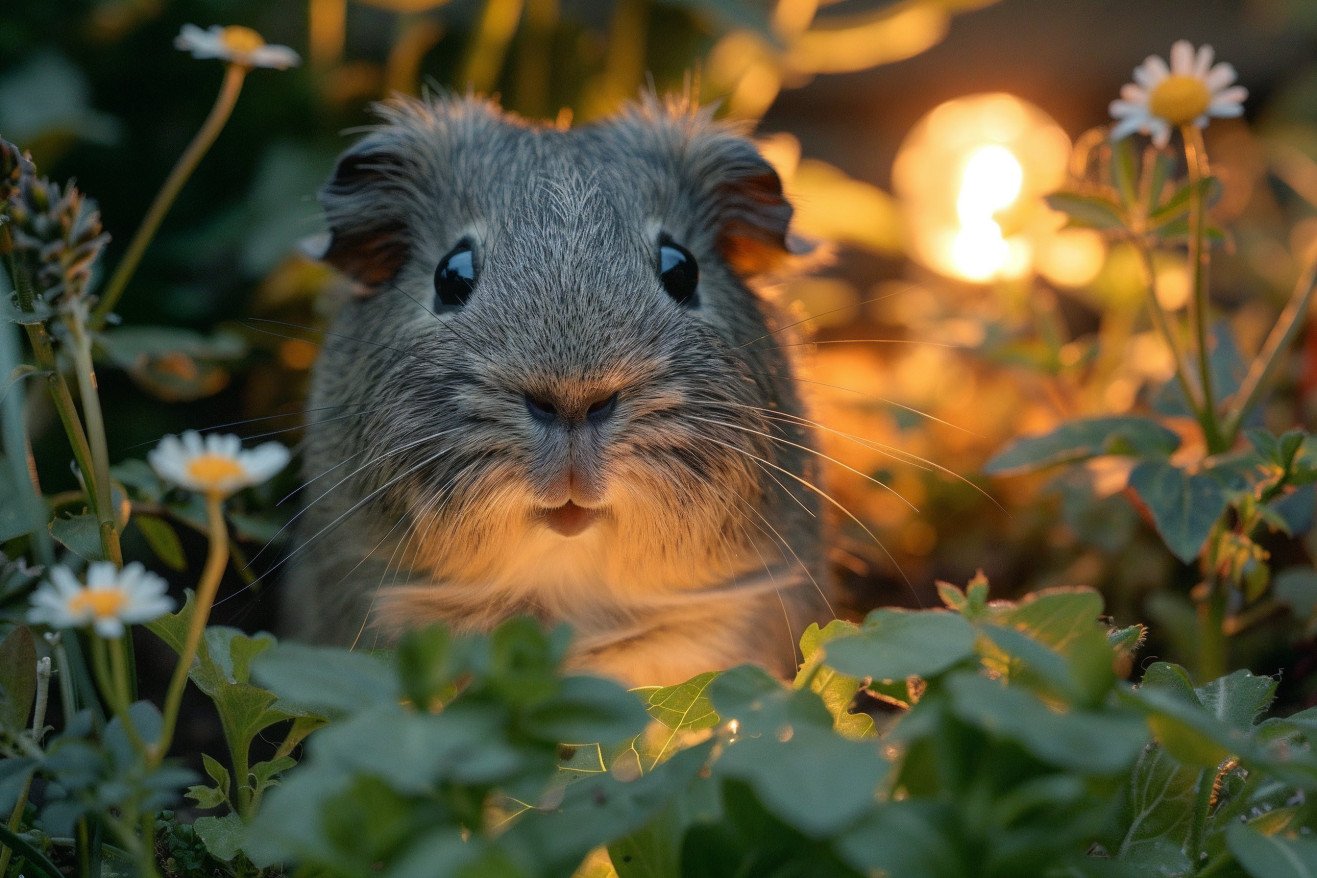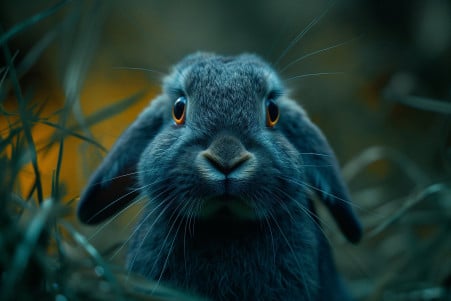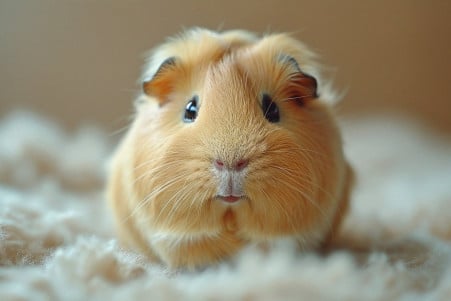Do Guinea Pigs Have Night Vision? What We Know About Their Ability to See in the Dark
15 February 2024 • Updated 14 February 2024

As the sun goes down and we flick on the lights, you may find yourself wondering how guinea pigs are able to see in the dark. While guinea pigs have some night vision, their ability to see in low light is supplemented by their sense of smell, hearing, and the sensory input they receive from their whiskers.
Although guinea pigs have a wide visual field, their lack of depth perception means they must rely on their memory and other senses to get around in the dark.
This article will explore what we know about guinea pigs’ ability to see in the dark by looking at zoological and veterinary research on their visual acuity and sensory adaptations. This exploration will involve research on guinea pig anatomy, as well as studies of guinea pig behavior and comparisons with other animals, to determine how guinea pigs make up for their poor night vision.
By the end of this article, you will have a well-rounded view of how guinea pigs see and experience the world after dark.
Do guinea pigs have night vision?
Looking at the Optics of Guinea Pig Eyes
The optical properties of guinea pig eyes can tell us a lot about the way guinea pigs see the world. The cornea, iris, and retina work together to create an optical system that, while not designed for high-resolution vision, does enable a large visual field.
While this large field is useful for detecting predators, it does limit the guinea pig’s ability to see in 3D and in high resolution. A paper in PMC shows that the guinea pig’s depth of focus is about 3.75 diopters, which means that they can see objects at different distances without having to refocus too much.
However, the optical quality of their eyes, which is marked by higher order aberrations, is lower than that of humans. This means that while human eyes may be able to see in higher resolution at longer distances, guinea pigs are limited to lower spatial frequencies.
In addition, a paper in IOVS shows that guinea pigs have a higher RMS wavefront error than humans for the same pupil size, which means that they have more optical aberrations.
These aberrations impact the quality of the retinal image, which is important for guinea pigs to be able to detect movement and get around.
However, guinea pigs can compensate for these aberrations through neuroanatomical adaptations and some accommodation, which means that their eyes can change focus.
How Guinea Pigs Use Their Senses to Get Around in the Dark
While guinea pigs have some night vision, their other senses are more important for helping them understand the world around them in the dark. Guinea pigs have a good sense of hearing, which helps them detect important sounds.
However, their sense of smell is the most important sense for helping them understand their environment when it’s dark. A study in PubMed found that guinea pigs have a high level of functional activity in their olfactory bulbs from an early age, which helps them detect a wide range of smells that help them understand their environment.
Whiskers are a type of tactile sense that help guinea pigs understand the world around them by acting as environmental radars that help them understand the objects and spaces around them. This kind of tactile feedback is especially important when visual feedback is limited.
In addition, the role of the vomeronasal organ (VNO) in guinea pig sensory perception is important. A study in PubMed by G K Beauchamp found that the VNO is important for maintaining responsiveness to sex odors, but that its removal doesn’t affect normal sexual behavior, suggesting that other sensory systems can make up for its loss.
This network of non-visual senses helps guinea pigs make up for their lack of vision by improving their ability to sense, communicate, and move around in low-light conditions. Knowing about these adaptations not only helps us understand how guinea pigs have survived but also how their social interactions have evolved during the nighttime hours.
How Guinea Pigs Move Through the Twilight
A-Z Animals explains that the crepuscular nature of guinea pigs means they are most active during dawn and dusk, and this is a perfect match for their sensory system that allows them to see well in low-light conditions.
As a result, guinea pigs are able to adjust their behaviors to the lower light levels and even develop a spatial memory that helps them move through their environment when light levels are low, which means they don’t have to rely on their vision as much.
In addition, A-Z Animals notes that guinea pigs burrow and hide in response to their environment, and this is particularly applicable for domesticated guinea pigs who often seek out cardboard boxes or cloth pouches to conceal themselves. This behavior is a remnant from their wild ancestors who had to shelter from nocturnal predators, and it demonstrates the significance of ensuring your guinea pig feels secure in their surroundings.
Social behaviors and vocal communication are also important tools that guinea pigs use to move through their environment when light levels are low.
Guinea Pig Awareness Week explains that guinea pigs use a range of vocalizations from squeaks to purrs to communicate with each other, and these sounds can indicate happiness or stress, which helps groups of guinea pigs coordinate and bond.
In addition, guinea pigs use their excellent sense of hearing and smell to communicate with each other, and this allows them to have complex interactions with each other even when they can’t see each other well in the dark.
Although guinea pigs are well-adapted to moving through the dark, when you look at how other animals have adapted to their environments, you can see that evolution has led to a wide range of adaptations to moving through the dark.
Shedding Light on the Dark: Guinea Pigs in Comparison to Their Nocturnal Relatives
In the context of other nocturnal and crepuscular animals, guinea pigs are a fascinating example of evolution in action. While many of their nocturnal relatives have evolved retinas that are packed with rod cells to enhance their night vision, guinea pigs have relatively poor night vision.
This suggests that there has been a trade-off, where guinea pigs have evolved enhanced hearing and olfactory abilities at the expense of their vision, which is consistent with their role as prey animals that need to rely on senses other than vision to survive.
As noted by Massive Science, the research indicates that guinea pigs’ ancestors likely had better night vision. As also noted by Noldus, the transition from wild cavies to domesticated guinea pigs has been accompanied by many behavioral and physiological changes.
Since they are now domesticated and depend on humans for their care, domestic guinea pigs no longer need the excellent night vision that their wild ancestors may have used to forage and avoid predators in the dark.
This comparison helps to provide a more complete picture of guinea pig senses and the ways in which they have evolved. It also underscores the importance of understanding the needs of guinea pigs, which are shaped by both their evolutionary history and their current status as domesticated animals. For those who love and care for guinea pigs, understanding these sensory differences is important for ensuring the welfare of these animals.
How to Make a Sensory-Sensitive Space for Your Guinea Pig
For guinea pig owners, this means setting up an environment that caters to their natural tendencies and makes up for their lack of night vision.
To make sure your guinea pigs are comfortable in a low-light setting, you can use dim lighting or even set up a twilight setting, as guinea pigs are most active at dawn and dusk, according to A-Z Animals. This will not only ensure their comfort but also help them engage in their natural behaviors.
For sensory enrichment, the RSPCA suggests adding things that will stimulate their senses of smell and touch, like hiding places that are made of non-toxic wood shavings or aspen wood, and tunnels that will help them engage in their natural burrowing behaviors. Regular health checks, especially to make sure their eyes and other senses are still working well, will help you make sure that they’re healthy and happy.
Watching your guinea pigs at night will help you better understand their behaviors and needs. By making sure that your guinea pigs are in an environment where they feel comfortable and can engage in their natural behaviors, you’ll be setting them up for success. This well-rounded approach to guinea pig care, which is based on a deep understanding of their senses, will help you create a loving environment for these wonderful pets.
Unraveling the Mysteries of the Night: A Final Look at Guinea Pig Vision
Throughout our exploration into the world of guinea pig vision, we have learned that while guinea pigs’ night vision is poor, their sensory modifications and behavioral adjustments more than compensate for this shortcoming. With their eyes adapted for peripheral rather than binocular vision, guinea pigs have learned to rely on their senses of hearing, smell, and touch to compensate for their lack of night vision.
Our comparative study has shown the evolutionary trade-offs that have led to a reliance on hearing and smell rather than vision. This evolutionary background is important for understanding how both wild and domestic guinea pigs interact with their crepuscular environment.
For guinea pig owners, the takeaways are that they need to create a safe and stimulating environment that takes into account guinea pigs’ unique sensory needs. This means ensuring that the light levels in their environment are low enough to match the natural light levels during guinea pigs’ peak activity periods at dawn and dusk, and that their environments include tactile and olfactory stimulation.
In the end, we are left with a sense of the complexity of guinea pig sensory systems. These animals have evolved a unique set of adaptations that allow them to thrive in their specific ecological niche, showing that there is indeed more to their world than meets the eye.


